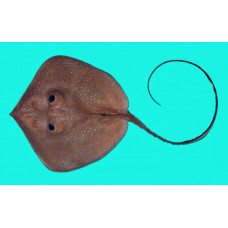Latin name
Maculabatis gerrardi
Other name
Sharpnose stingray
Identification
The pectoral fins of these rays fuse with the head to form a diamond-shaped flat disc, wider than long, with the edges of the fins ("wings") meeting at almost right angles. The pointed tip of the triangular snout protrudes beyond the edges of the disc. There are spiracles behind the eyes. On the ventral surface of the disc are 5 pairs of gill slits, mouth and nostrils. A flap of skin with a fringed lower margin runs between the nostrils. The mouth is arched. The teeth are staggered and form a flat surface.
On the dorsal surface, in the central part of the caudal peduncle, there is a thin sting connected by ducts to the venom gland. Sometimes stingrays have two spines. Periodically the spines break off and a new one grows in their place.
Features of fish fins
Pelvic fins small and rounded. Whip-shaped, tapering to conical, the tail exceeding the width of the dorsal fin.
Fish colouring
Colouration of dorsal surface of White-spotted Whipray disc light brown with numerous white spots. Ventral surface of disc white.
Distribution
Widespread in the Indian and Pacific Oceans from Myanmar and the South and East China Seas to Indonesia and Taiwan.
Habitat
These rays are found on the outer edge of the continental shelf at depths of up to 60 metres. They prefer soft bottoms.
Size
The maximum recorded width of a whitespotted whipray disc is 200 cm.
Behavior
Whitespotted whiprays swim into river mouths. There is evidence of their presence in the Ganges.
Food and feeding habits
The diet of these rays consists of crustaceans, including prawns, crabs and small lobsters, bony fish and shellfish.
Reproduction
The whitespotted whipray is an oviparous fish. The embryos develop in the womb and feed on egg yolk and histotrophs. There are 1-4 newborns in a litter with a disc 18-21 cm wide. Males and females reach sexual maturity when the disc reaches 48 cm and 54 cm respectively.
Fishing
It is a targeted fishery. Intensive fishing is carried out using gillnets, bottom trawls and seines.
Relationship with a person
The meat, skin and cartilage of these fish are used.
| Classification | |
| Phylum | Chordata |
| Class | Chondrichthyes |
| Squad | Myliobatiformes |
| Family | Dasyatidae |
| Genus | Maculabatis |
| Species | M. gerrardi |
| Features | |
| Conservation status | Endangered |
| Habitat | Bottom |
| Life span, years | No information |
| Maximum body weight, kg | No information |
| Maximum length, cm | 200 |
| Sailing speed, m/s | No information |
| Threat to people | Edible |
| Way of eating | Predator |
Whitespotted whipray
Tags: whitespotted whipray

